
Based on some recent work we've been doing, it's becoming more and more apparent to me that there are two irreconcilable points-of-view around the role of brands. These views exist both within the agency world as well as the client world, and I'm not sure that you'll have any luck shaking a holder of either belief and convincing them of the other.
The one view says that brands are there to provide consistency and reassurance. They are designations of a familiar set of qualities and values. This view leads to brand communications that present an integrated front for the brand.
The other view says that brands are here to surprise and delight their customers. They inspire and enrich you by presenting new and interesting sides of themselves. This view leads to brand communications that, while based on a central belief, can look and feel purposefully diverse.
As in most black and white debates, I'm not sure either side is completely right or wrong, it would seem to depend on the context. However, I'd love to to see where you all fall.
Share ideas that inspire. FALLON PLANNERS (and co-conspirators) are freely invited to post trends, commentary, obscure ephemera and insightful rants regarding the experience of branding.
Thursday, November 30, 2006
The great divide.
Wednesday, November 29, 2006
British youth isolated by more than the Channel?
 The post below and one of the comments made me think about some recent conversations I've been having with my parents one of whom is a maths professor at King's College in London.
The post below and one of the comments made me think about some recent conversations I've been having with my parents one of whom is a maths professor at King's College in London.
King's is still a fairly respectable place to get a degree and so you'd assume it would get its share of high quality students. However, that doesn't seem to be the case. The students they see aren't terribly interesting, rounded or driven by anything greater than a desire to get a job in an accountancy in the City.
This contrasts dramatically with what we see here. Over the past few years, I've been tremendously impressed with the young people I meet. Most of them are far more together and far more interesting than I was at their age. Data around the millenials in the US would seem to confirm that this isn't an isolated phenomenon. Overall, teens and young adults here (and in many countries around the world) are more conected, ambitious, driven, diverse and creative than my generation ever was.
And this is true amost everywhere, except Britain.
In the US, teen drinking and smoking have declined steadily since 1996. In the UK teen drinking has risen steadily since 1990 and British youth are now the heaviest drinkers in Europe.
Teen violence here has also declined dramatically since the early 90s, while again UK youths are found to be among the worst in Europe. In fact ASBOs - anti social behaviour orders - introduced in 1998 as a way to stop the random violence and unruly behaviour of British youth have now, in some circles, become a badge of honour.
Even more troubling is the dramatic rise in binge drinking and violence among British girls. Some studies even say that British girls drink more than their male counterparts.
As someone who grew up in London, it feels all too familiar. I am often amazed when I talk with Americans about their experiences growing up. Most got through their entire childhoods without ever fighting anyone. I rarely got through a week at some points.
I was reminded again of the differences when doing global research last year. British youth used alcohol as a way to let their hair down, drop the facade and let go of the stifling peer pressure to conform. American youth we talked with couldn't relate at all. They actively work at being individuals not part of the pack. They choose friends often by how different they are from one another not how alike.
To me these differences are troubling because they lead to a possible conclusion that Britain will become increasingly out of step with the rest of the world. The millenials are poised to define this country and reshape it to fit their values. What impact will the youth of Britain have on it future?
Tuesday, November 28, 2006
Is the door closing? What then?
 Last year, Roper proclaimed that we were in a "hinge period" where consumers were exceptionally open to new ideas and new ways of doing things. I am getting the distinct feeling that the door is swinging shut.
Last year, Roper proclaimed that we were in a "hinge period" where consumers were exceptionally open to new ideas and new ways of doing things. I am getting the distinct feeling that the door is swinging shut.
I do not have a particular case here, but a lot of observations seem to point that way.
We have just experienced a period of rapid expansion of what I often (perhaps tiringly) call Personal Autonomy. Or, more simply put, we discover new avenues from which to exercise our free will. When these freedoms present themselves, most of us gladly take it (and like it, thank you). But as has been predicted by others, this phenomena is accompanied by a corresponding increase in societal anxiety. Our stabilizing institutions are called into question as consumers become increasingly self-reliant. Those who place great weight in stability are particularly stressed. They no longer recognize the world we live in. The self-reliant become frustrated because institutions can not repond quickly enough to our demands or expectations for greater control and responsiveness.
This reaction is increasingly clear in our American political and social arenas. However, this is a global phenenomena with global symptoms. Evidence includes the fact that governments all over are lurching from one side to another following elections. The plethora of "happiness" research that appears trendy right now seems to point towards a growing malaise. Stress, as measured by many polls is high, despite generally decent economic conditions. For all the attention given to social networking sites such as MySpace, spend some time there and you can almost taste the boredom, and in some cases, sadness in the content there.
This is not meant as a doom and gloom observation. There is something generalizable about Newton's 3rd Law (For every action, there is an equal and opposite reaction). I think we are entering a period of absorption. New boundaries have to be discovered, before we can tear it down once again.
Does anyone else sense this? If so, what does it mean for brands and branding? With so many brands tied to innovation, evolution and constant, rapid change, what if consumers suddenly want familiarity and stability? Will consumers turn inward? Are we waiting for an event or idea to coalesce around? I don't have any answers but I feel a change is afoot.
Believer in Games
Speaking of games, I need to give another plug for everyone’s favourite magazine Believer (see my previous post for why it’s a great mag).
They had a great ‘games’ issue a couple of months ago which covered all kinds of gaming not just the video sort, but In particular an interesting article about video games as propaganda caught my eye.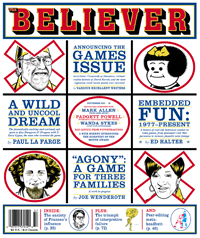
It looks at the fusion of war games with real wars… ie how we used to play games for wars long past (WWII, Vietnam, Roman Empire etc), but that increasingly things are much more current… Iraq is the example they get into where semi-real, almost current news footage is spliced into the game action and mission setup. (I’d also point to the sublime to play Rainbow Six series as basically a sequence of not so subtle war-on-terror set pieces which you play out.)
It’s a thoughtful and fairly balanced article on violent and/or potentially mind forming games by most media standards, but a large part of it is critical and voices ‘qualitative’ differences on grounds od principle between filming a story about say Vietnam or WWII and making a game about it.
In contrast I have to say I’ve always found that the best gaming experiences are rather less jingoistic and narrow minded than most filmic depictions of war. This is largely because, although as the article points out you keep getting to play again until the ‘right side wins’, you also have the experiences and choices of defeat, death and doing bad things, (killing your own men/prisoners,/yourself etc).
Call of Duty for example, despite it's ocassionally lazy marketing, is basically an interactive Saving Private Ryan without the schmaltz and bull... in fact scrap that, it is closer to a playable Band of Brothers than a Saving Ryan. In other words it's far more real, far more moving, far less 'message'.
The fact it’s hard and you fail time and again in both small and big ways (getting across Red Square alive / completing a mission) is what makes it more fun and also, to me, less patronizing about the realities of war. On an aside - failure and degree of difficulty are two of the interesting factors that makes games addictive in the first place, which should have lessons for us in marketing (make things too easy at your peril).
Video games are of course 99% wildly silly fiction, but because you have to choose and because you can and will fail, they can be far more ‘real’ and consequence-explicit than is managed by most movies, TV Documentaries… or the real news for that matter. Which is kind of scary considering they are after all clearly categorized as ‘games’.
Monday, November 27, 2006
Wanted: Senior Planner @ Fallon
Are you interested in working at a great planning agency?
Fallon needs a senior planner with at least 5-8 years of experience to take the principal position on an important international account. We're looking for someone who has the confidence and character to take a lead role in working closely with strong client marketing and research departments, directing the day-to-day responsibilities on multiple brands, and ultimately inspiring effective creative work.
Fluency in Spanish and/or Portuguese is a major bonus, as well as experience with CPG/FMCG. Must be willing to travel frequently within the United States as well as to Central and South America.
If you think you've got it what it takes, tell us why in no more than 100 words. Send your response and resume to deborah.zavitka@fallon.com.
The United Church of Canada Emerging Spirit Campaign
Check out the print campaign of 6 ads--lower left corner--and the web-based video with the squirrel--lower right corner.
The print goes from Jesus turned Santa Claus to Bobblehead Jesus.
In a television interview this morning (I think on Good Morning, America) there was no response when asked about the print ad that says: "How much fun can sex be before it's a sin?"
For more information about the campaign go to:
http://www.united-church.ca/gco/061110.shtm
Answers to Questions about the Emerging Spirit Ad Campaign by
The Rev. Dr. Jim Sinclair, General Secretary, General Council,
The United Church of Canada, a sampling of which is listed below.
"The Emerging Spirit ads are designed to attract attention, elicit conversation, and point people toward the WonderCafe website*. Their intent is not to make fun of personal religious belief or diminish basic religious understanding. Jesus probably looked for a similar reaction when he declared: It is easier for a camel to go through the eye of a needle than for a rich man to enter the kingdom of heaven.
The Emerging Spirit ad campaign is designed to communicate to a generation of primarily 30- to 45-year-olds who have very little or no knowledge of organized religion and the contemporary church. The ads are not intended to reach out to people who are already members and adherents of The United Church of Canada. These ads have been thoroughly tested with people in the age group they are intended for. We are confident the ads will attract the attention of 30- to 45-year-olds who don't go to church, and provoke discussion among them about faith and religion issues.
The Emerging Spirit ad campaign is not attempting to define what the United Church is all about. Rather, it is meant to raise questions about faith, religion, and other important questions of life, and invite discussion. It hopes to reach out to the millions of Canadians who feel that organized religion isn't relevant to their lifestyle and their lives. As a result, the ads must not feel "churchy" or be what many people would expect from The United Church of Canada. We are trying to get people to consider church in a different way. We believe these ads will do that."
Saturday, November 25, 2006
Wii Would Like To Play
I love the way the latest round of console wars has deepened some of the self made caricatures and divisions between Nintendo and Playstation. (I’m ignoring Xbox for sake of simplicity, although for the most part it reads pretty much exactly like Playstation)
Playstation swings between being about either the tech (HD graphics, BluRay, etc), or all about looking like a too-cool-for-school brand that you have to be on the inside track to understand.
Too-cool (and if you ask me feeling a little last century these days)
Check out my graphics:
(OK a Tekken ad not sony per se, but representative of the kind of stuff online about PS3)
Nintendo by contrast is almost anti-cool (more by naïve accident than design most of the time) and all about invention and people having fun.
Wii for all
(This is pretty good by Nintendo’s ad standards in the US)
I’ve long (vastly) simplified the difference between the two by saying a playstation owner says – “Check out the cool graphics, and wait while I show you this cut-scene.” While the Nintendo owner says “You’ve gotta play this, it’s great!” and hands you a controller.
But I had to laugh when I tried putting PS3 and then Wii into the airtight flickr related tag browser. Can you guess what kind of tagged images came up for each?
Hmmm just a load of screenshots.
What? People? Playing a game??? Weird.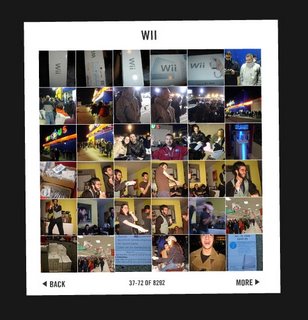
All good fun, but leaves me feeling that although PS3 is almost assured success despite its slightly dated ‘up-own-arse’ brand tone, I really hope that with it’s character and genuine inventiveness the Wii gets itself a decent market too.
Self-Service: Airlines Save Big
 Self Service Promises Big Savings For Airlines
Self Service Promises Big Savings For Airlines
Airlines are looking to realize billions of dollars worth of savings by investing heavily in self-service check-in technology, according to SITA, the air transport industry IT services group.
The number of airline passengers using check-in kiosks will rise from 27 percent in 2006 to 38 percent by the end of 2007, according to SITA's 8th Annual Airline IT Trends Survey carried out in conjunction with Airline Business magazine.
The survey also revealed that nearly 30 percent of airline tickets worldwide are currently sold online, up from 20 percent in 2005.
"The speed at which the industry is moving towards a self-service passenger model is clearly borne out by the technology investment priorities of airlines," Francesco Violante, SITA's CEO, says in a statement. "Eighty percent of airlines responding to the survey see projects with proven payback and cost savings, such as online booking, bar-coded boarding passes and self-service check-in, as their highest priority, up from 50 percent last year."
British Airways (BA) converted all its check-in for UK domestic flights to self-service in April 2006, according to a company statement. The airline is installing 96 check-in kiosks at Terminal 5, its new London-Heathrow terminal, which is currently under construction.
BA says it anticipates that 80 per cent of customers departing from Heathrow will check in online via the airline's website, ba.com, or use a self-service check-in kiosk. "Self-service check-in, both online and at airport kiosks, has been very well received by our customers," Willie Walsh, British Airways' chief executive, says in a statement.
Thursday, November 23, 2006
Second Life: Amsterdam Island
Prompted by a comment on an earlier SL post I made, I decided to search for Amsterdam Island within SL. After a bit of exploring, I found it and, to be honest, the creators have done a somewhat decent job of recreating parts of the real city.
The canals and boardwalks are represented and do hold a bit of the actual city's charm..
And we even find an homage to one of the many churches in a-dam...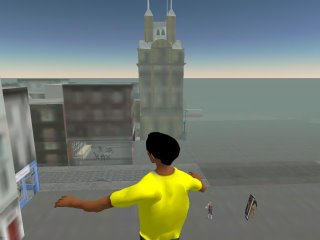
Of course, it wouldn't be true re-creation without the red curtains and shady peeps of the Red Light District.
While I've been enjoying exploring Second Life, Alyson's post did get me thinking. It doesn't surprise me really, that crime finally popped up in this world. It's unfortunate though; I approached Second Life as a leisure activity, and (perhaps naively) didn't think about the other implications.
What does it say about us? Even in a world where, we don't have to eat, we don't have to sleep, we need literally nothing to be alive, there are still those among us that would choose to take what they don't own, to hurt those who don't deserve it, to corrupt a world that was once pure (relatively speaking)?
Not that I claim to be perfect by any means, but it just got me thinking. What sparked the need to steal, to be violent, to pollute this virtual world? Was Ghandi wrong? Are people not inherently good? Do we actually desire to hurt one another?
Though I still have great interest in expolring Second Life, its a trip to think that, what I approached as an opportunity to explore new media, others found it to be a way to steal from, hurt, and cheat other people. A damn shame.
Tuesday, November 21, 2006
Second Life: The Dark Side
 BusinessWeek.com has an article on the "Dark Side" of Second Life. No, it's not a George Lucas inspired community, but an increasing rate of crime and "first life" issues in the animated world. A program dubbed "Copybot" allows users to steal fellow Second Lifers' hard-earned (or coded) possessions, effectively devaluing the Linden dollar and causing temporary economic havoc. Some SL entrepreneurs have even shut their stores until Linden Labs takes protective action. While users employing Copybot can be banned, no further structure or regulation exists for simliar infractions.
BusinessWeek.com has an article on the "Dark Side" of Second Life. No, it's not a George Lucas inspired community, but an increasing rate of crime and "first life" issues in the animated world. A program dubbed "Copybot" allows users to steal fellow Second Lifers' hard-earned (or coded) possessions, effectively devaluing the Linden dollar and causing temporary economic havoc. Some SL entrepreneurs have even shut their stores until Linden Labs takes protective action. While users employing Copybot can be banned, no further structure or regulation exists for simliar infractions.
This isn't the first time that Second Life has encountered real world issues; last spring saw a lawsuit over virtual land theft. However, for a site that sees itself more as a social networking platform than an online game, resolving such economic and social issues could be paramount to continued growth.The biggest challenge facing SL right now is scale: there simply aren't enough active users for it to be a mass media outlet (averaging about 10,000 people on the site at any given time).
Perhaps there are unique sponsorship opportunities available that could kill two birds with one stone. An established media franchise like "Law and Order" could partner with Second Life to provide both a service (law and order) while also bringing established viewers online. Granted, real-time Law and Order: Second Life "ripped from the headlines" episodes might need a little goosing to be interesting, but it could be the ultimate media mash-up. Cops meets Survivor meets CSI meets CNN. Serialized conflict is nothing if not entertaining. Who knows? Maybe a Dark Side is just what Second Life needs.
Granted, real-time Law and Order: Second Life "ripped from the headlines" episodes might need a little goosing to be interesting, but it could be the ultimate media mash-up. Cops meets Survivor meets CSI meets CNN. Serialized conflict is nothing if not entertaining. Who knows? Maybe a Dark Side is just what Second Life needs.
Bankrupt!: Young And In Debt
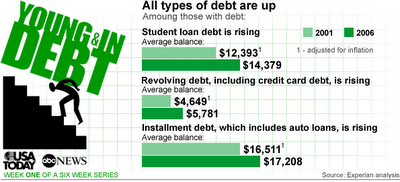
USA Today, in a partnership with ABC News offers a 6-week series, Young & In Debt, featuring an exclusive poll with the National Endowment for Financial Education and exclusive database analysis of credit reports of 3 million twenty-somethings by Experian.
The series, running from November 20 to December 29, 2006, will profile five twenty-something readers and their financial challenges. Articles will appear in USA TODAY on Mondays and Fridays, addressing issues such as: saving for a first home, setting financial goals, obtaining insurance, paying off college debt, online components include video, quizzes and financial calculators
Some data highlights:
This generation of twentysomethings is straining under the weight of college loans and other debt, a crushing load that separates it from every previous generation.
Nearly two-thirds carry some debt, and those with debt have taken on more in the past five years, according to an analysis of the credit records of 3 million twentysomethings that Experian, the credit-reporting agency, did for USA TODAY. Their late payments are rising, and they're more likely to be late than other Americans are.
Nearly half of twentysomethings have stopped paying a debt, forcing lenders to "charge off" the debt and sell it to a collection agency, or had cars repossessed or sought bankruptcy protection.
High debt loads are causing anxiety, too. A poll of twentysomethings by USA TODAY and the National Endowment for Financial Education (NEFE) found 60% feel they're facing tougher financial pressures than young people did in previous generations. And 30% say they worry frequently about their debt.
Although the percentage of people ages 22 to 29 with debt has declined, their total debt is up 10%, to an average $16,120 as of Aug. 1, compared with five years earlier, Experian's analysis found. Every type of debt — from credit cards to college to personal loans — has risen.
Student-loan balances rose 16% to an average of $14,379; revolving debt, including credit cards, surged 24% to $5,781; and total installment debt, including student and personal loans, rose 4% to $17,208. (Comparisons are adjusted for inflation.)
Among all twentysomethings, the fastest-growing group owes $20,000 or more in student-loan debt. Though it's a small group, its proportion has doubled in the past five years to 3%.
Debt has forced some young people to change their career plans. Of those surveyed, 22% say they've taken a job they otherwise wouldn't have because they needed more money to pay off student-loan debt. Twenty-nine percent say they've put off or chosen not to pursue more education because they have so much debt already. And 26% have put off buying a home for the same reason.
A smaller percentage say they've put off marrying (11%) or having children (14%).
The Boomerang Generation — young adults who return to live with their parents — is real, too. In the poll, of 910 twentysomethings, 19% said they've moved back with parents to cut costs. The 2000 Census found that more than 25% of 18- to 34-year-olds had moved back in with family at the time the Census was taken.
Experience Inc., which provides career services to link college grads with jobs, found that 58% of twentysomethings it surveyed in July had moved back home after college. Of those, 32% stayed for more than a year, according to its survey of 320.
"The reliance on family for this generation is very, very different from prior generations," says Jennifer Floren, CEO of Experience. "They're living under the shelter — financial and otherwise — of Mom and Dad for much longer. "
Many young people fear they won't be able to count on Social Security or on company pensions. Meantime, they're being urged to save early for their retirement.
Yet many can't, and most aren't. Fifty-five percent aren't saving in either an individual retirement account or a 401(k) account, and 40% don't have a savings account they contribute to regularly, according to the USA TODAY/NEFE poll.
 Generation Debt? Or Generation Whine? What exactly is tougher about the financial challenges facing today's young adults?
Generation Debt? Or Generation Whine? What exactly is tougher about the financial challenges facing today's young adults?
•Skyrocketing tuition. The average price of college has grown much faster than the rate of inflation. Average annual tuition at public four-year colleges and universities is $5,836 in 2006-07, up 268% from 1976-77, according to the U.S. Education Department and the National Center for Education Statistics. Private college tuition is up 248% to $22,218 a year.
•Declining student grants. Though total federal student aid has grown sharply, so has the proportion of people in college. In 2004, 67% of high school graduates enrolled in college; in 1972, only 49% did. As a result, student grants cover only 39% of the costs of a four-year college today, compared with nearly 80% in the mid-1970s, the College Board says.
•Soaring student-loan debt. Students have generally made up the gap between what colleges charge and what they can afford by borrowing. The percentage of students who borrowed for college jumped to 65% in 2000-01 from 34% in 1977, the National Center for Education Statistics says.
And they use credit cards to help pay for books and other items. Half of all graduates in 2004 used credit cards for school expenses, the American Council on Education found.
•Flat wages. Once students graduate, jobs don't pay what they used to.
Thirty years ago, a male college graduate could make the equivalent of $51,223 a year in 2004 inflation-adjusted dollars. In 2004, he earned less: $50,700, according to the NCES. Wages for women, though, have risen.
•Rising home prices. It takes a greater portion of the average income to buy a median-price home today. In 1970, it was 17%; in 2005, 22.4%. The median price of a home was $23,000 in 1970. Adjusted for inflation, that's $115,770 — barely more than half the median price of $219,000 in 2005.
Wanted: Senior Planner @ Fallon
Are you interested in working at a great planning agency?
Fallon needs a senior planner with at least 5-8 years of experience to take the principal position on an important international account. We're looking for someone who has the confidence and character to take a lead role in working closely with strong client marketing and research departments, directing the day-to-day responsibilities on multiple brands, and ultimately inspiring effective creative work.
Fluency in Spanish and/or Portuguese is a major bonus, as well as experience with CPG/FMCG. Must be willing to travel frequently within the United States as well as to Central and South America.
If you think you've got it what it takes, tell us why in no more than 100 words. Send your response and resume to deborah.zavitka@fallon.com.
Monday, November 20, 2006
A Note on Differentiation
"I don't think we're so different, it's just that everyone's trying to be the same." -Pos Dnous
I, for one, am sick of using the phrase "sea of sameness" when referring to competitive advertising. Anyone else? I, especially, am getting tired of it because being that I'm on The Bahamas account, it's often followed up with "no pun intended" or "literally" by various team members. In fact, that phrase is so overused that our clients would be right to call us out for a "setup of sameness." And don't tell me that's not true of a lot of the marketing jargon.
Anyway, it's not so hard to stand out when the creative bar has been set so low in category, and from my experience, there's usually some brand that we strategically choose to ignore when showing this "sea" because they actually aren't quite that blue and wet. As we're helping companies (or governments in this case) differentiate and create salient communications, this is a reminder that different for different's sake isn't good enough and sooner or later, you're going to have to define what your brand is really about and live it.
Seems we're doing a fair amount of "Behind the Scenes" stuff lately to give people a peek inside the communications process from recaping strategy to showing all the elements of production. It's a step in the right direction of companies showing the real people, work, and often issues and challenges associated with communicating their brand. Not necessarily presupposing that people care, but taking one step toward being more interesting and transparent (than the past and than their competitors).
Forgot what site put me onto this (so apologies for no love), but have had a link to this video hanging out on my desktop for a while (so apologies if you've already seen it) and thought it was about time I pass it on. It's an old-school De la Soul press kit that defines there reason for being, authentically and unapologetically, and shows why it's easy to hop on board the "Soul Train." Okay, sorry. Roll the clip:
Saturday, November 18, 2006
Speaking of Virtual Worlds...

While they're no substitute for meeting in person, they're damn important and useful as a tool to form, maintain friendships, and continue dialogue, especially when distance is an issue. And sometimes they mimmick the real world. I know because I just simultaneously commented with Russell on Noah's blog.
Is it just a coincidence? Or is it possible that because we all met for coffee at the same time exactly a week ago in NY, we were trying to recreate that togetherness? At the very least, we were reminded of Noah and thought to check on his week's thoughts.
But then again, I'm all about overthinking and even conspiracy theories.
Friday, November 17, 2006
Second Life: Exploring the Expanse
As tempting as the bling you get from sitting in the chairs at H&M sounded, I decided to go out and do some exploring today.
When you want to go somewhere in Second Life, there's an option where you can "search" for locations. Type in generic terms like "store" and you get myriad options between stores set up by residents and those put up by real-world companies. When you find a place you want to visit, you can opt to "teleport" to the location, and SL will instantly send you there.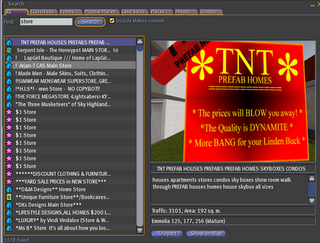
But reality is what it is, I spend too much damn money in real life, can't go buying shit in SL. So, I move on...
I did come back to H&M to find Aki Octagon asleep (aka "away"). He's dedicated to the cause, not leaving till he gets that bling in his hand, his second piece of ice yet. He got the first prize, the diamond earings, but he's going for it all.
Went to check out the Reuters spot, see what that was about. For those that don't know, Reuters angle into Second Life (I posted about it a little while back) was to put one of their media corespondents in as their "bureau chief" in SL. I'm sure his virtual self is enjoying it in this crib.
What I'm starting to discover (as Aki hinted at in his post) is how, even though I sit 5 feet away from another live human being, I still search for interaction within SL. Though (in First Life) I'm more often than not the type that prefers the company of just a few, I find myself searching for where the masses congregate in SL. +1 million residents yet I've only run into other Second Life inhabitants in few places (H&M comes to mind, the place where Aki has chosen to camp out in order to rack up the bling).
Perhaps its just because I don't quite fully understand how to navigate the world yet, but I find myself flying around, finding sporadic pieces of land with random building structures, yet zero signs of activity. Admittedly my "avatar" is essentially my eyes seeing into this world and I'm comparing it too closely to my first life, but its erie seeing developed infrastructure, well-designed rooms, in seemingly city-like places with no inhabitants in sight. Walking around a mall or going into a club and being the only person there is a strange feeling, I must say.
Soon enough, we'll figure it out and we'll be reporting back on - or perhaps even creating- the hot spots where the residents want to be in SL.
Inbox of Immaturity

Congrats Emmitt! So while Aki and Desi are putzing around in Second Life, I'm making sure the rest us have an equally entertaining diversion. Here's the goodness for the week:
Really one standout fwd this week in the form of Japanese TV's "Chimpan News". The shows lead is “"There are 13.5 million elementary school students in Japan. The number of registered dogs is 17 million. Therefore TV stations should create programs for animals, rather than children. So this is the program for animals, presented by animals." See the camel's amazing tux
Also we have some solid music for the hip hop afficionados:
Sick freestyle impersonation by Aries Spears
The new Nas and Jay-Z collabo
And finally some COLLEGE! love:
Van Wilder 2 without van: The Rise of Taj
Students at my alma mater find a loophole
Second Life: Aki Octagon - Day 2
Aki Octagon travels in Second Life - wish you were here!
Toured BBH offices...kinda quiet today. 
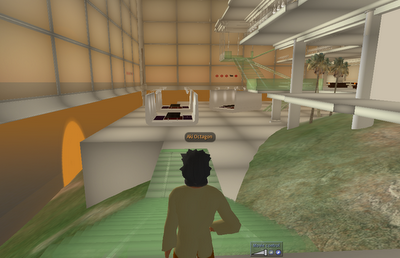
Visted Leo Burnett (under construction), currently an apple tree under glass enclosure

Shopped (and loitered) at H&M for the free bling...see Avin's post below to get your's, playa! Lots of friendly strangers to meet here, too.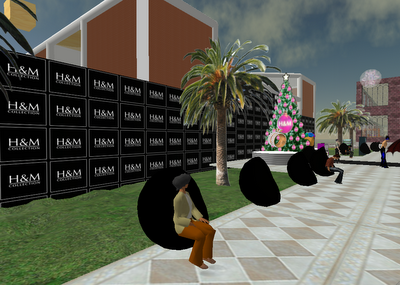
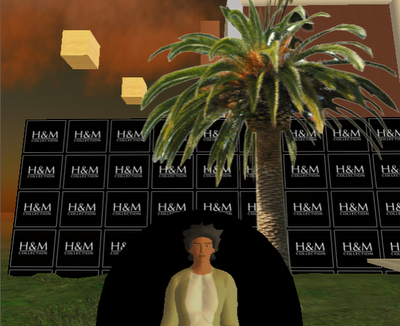
Frolicking about near Wired Magazine's HQ
...And still rockin' my high-waist brown trousers!
Second Life: Following Suit, Aki and I See Who Gets the Diamond First

I set up my Second Life avatar in the last few days as well, Desi Stoneage. Don't ask why I chose the name. The way it works in SL lets you pick your own first name, but you have to choose from a list of provided last names. I felt like picking something odd. Its only my Second Life after all.
So in my first day of being a Second Lifer, Aki (Spicer, not Octagon) tipped me off to a little H&M goodie. Inside their store within SL, they have chairs set up in the lobby for people to sit. The cool part is, the longer you sit, the more gifts you rack up.
If you sit for 120 minutes, you get some blinged out diamond studs.
Sit for 240, its a diamond cross pendant necklace.
For 360 mins, you get a "formal diamond necklace".
All prizes worth a solid chunk of Linden dough. And since I really don't have much use for that formal diamond necklace (not like I have a wife in Second Life), I figure I can cash that in somewhere for the hard cash. I wonder what I'll buy first.
Thursday, November 16, 2006
Second Life: Aki Octagon - Day 1
 I created my Second Life avatar, today. Aki Octagon.
I created my Second Life avatar, today. Aki Octagon.
My first few hours mirror the first 3 years of First Life - ie awkwardly forming my body and features and learning to walk (and fly). It takes a full 40 minutes just to make my hair. Upon mastering the hair and basic physics, I am now ready to forge a place in this world.
The next few hours then mirror the independent adolescence of our First Lives - wandering around unfettered and defiant of rules...directionless and lacking any higher purpose.
In Second Life we are free to define our purpose however we see fit. Yet, with so much autonomy I become bored and confused. In a world where one is free to do just about whatever (fly, teleport, explore), I find my Second Life empty without program missions. "What do I want to do with so much Second Life ahead of me?" What purpose shall I forge for myself here in this Second Life that First Life doesn't afford?
I practice learning to speak with a parrot who befriends me and repeats everything I say. The sun sets while First Life Aki eats a burrito. Second Life world progresses forward while you're away from the computer, Aki Octagon merely "sleeps" hovering above the island awaiting instructions.
Amidst all this undeveloped frontier (mostly fantasia mountainscapes and surreal pyramids and public "parks"), I find myself desperately in search of the other people. Not that I have anything to say to them when I do find other people. Still, the presence and proximity of others is comforting and compelling.
Aki Octagon requires no food. There is no natural hardship or decay here. No competition or conflict, no (need for) violence. No hunting for sustenance, no natural threats, no fighting for survival.
However, one does need to procure Linden Dollars to purchase any luxuries and badges in Second Life (like a pair of designer eyeglasses, which I hardly need here). Might Aki Octagon remain content as a wandering savage with little property or possessions? As in First Life, procurring extras requires that Aki Octagon get himself a job and start making some dough to upgrade lifestyle.
Tomorrow, in search of brands and brand lands!
Looking for Senior Planner
Are you interested in working at a great planning agency?
Fallon needs a senior planner with at least 5-8 years of experience to take the principal position on an important international account. We're looking for someone who has the confidence and character to take a lead role in working closely with strong client marketing and research departments, directing the day-to-day responsibilities on multiple brands, and ultimately inspiring effective creative work.
Fluency in Spanish and/or Portuguese is a major bonus, as well as experience with CPG/FMCG. Must be willing to travel frequently within the United States as well as to Central and South America.
If you think you've got it what it takes, tell us why in no more than 100 words. Send your response and resume to deborah.zavitka@fallon.com.
Connecting Consumers Virtual Lives with Their Real World Needs

Joining the rush of companies and advertisers into Second Life, Dell announced that they would be setting up shop an unveiled Dell Island. The island will have a factory, museum, a virtual conference room where focus groups and executive meetings will be held, and even a replica of the dorm room where Michael Dell crafted his plans for the computer industry. Not a particularly stunning move as Dell is joining the ranks of big corporations entering SL, but I thought the quote (title of this post) was a good way to sum up why all these companies are getting into this virtual world. In addition to trying to up their "cool factor" and be more relevant in the eyes of the first-movers and early-tech adopters, the reality is they want to make money. Investing all of this time and resources into opening up a virtual facade of the company should accomplish more than just getting people to think you're "cool": the hope is its also going to have a positive affect on the bottom line.
Not a particularly stunning move as Dell is joining the ranks of big corporations entering SL, but I thought the quote (title of this post) was a good way to sum up why all these companies are getting into this virtual world. In addition to trying to up their "cool factor" and be more relevant in the eyes of the first-movers and early-tech adopters, the reality is they want to make money. Investing all of this time and resources into opening up a virtual facade of the company should accomplish more than just getting people to think you're "cool": the hope is its also going to have a positive affect on the bottom line.
In the case of Dell, Second Life residents can go to the virtual factory, customize their Dell and purchase, and their PC arrives at their real-life door. "It connects virtual reality with real world commerce" as one Dell senior VP states.
Wednesday, November 15, 2006
Second Life: Robotic Fish @ London Aquarium

Created by robotics experts from Essex University, east of London, the creatures move around the tank like real fish, but unlike previous attempts at robotic fish, these are not pre-programmed.
Instead, they have sensor-based controls, meaning they move around the tank, avoiding objects and other fish, and reacting to their environment as a real fish would.
Professor Huosheng Hu, of the university's computer science department, said the aim of creating the fish and having them on display in a public place was to increase awareness about robots' capabilities.
He said the robotic fish, which took three years to create, could also be used in the ocean.
"This work has many real-world applications including seabed exploration, detecting leaks in oil pipelines, mine countermeasures, and improving the performance of underwater vehicles," he said.
Hu and his team wanted to create the ultimate fish: Aiming to emulate the speed of tuna, acceleration of a pike, and the navigating skills of an eel.
see VIDEO
BBC reports
MSNBC reports
Mass Interactive: Save The Virgin
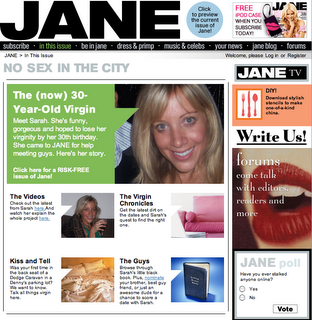 I am late to this phenomenon, but seems this lonely 30-year-old needs all our help (and voyeurism) in meeting Mr. Right-On. Check out her ongoing updates at Jane Magazine and cast your mass votes and voice your positions on this real-time soap opera.
I am late to this phenomenon, but seems this lonely 30-year-old needs all our help (and voyeurism) in meeting Mr. Right-On. Check out her ongoing updates at Jane Magazine and cast your mass votes and voice your positions on this real-time soap opera.
AKI COMMENT: Maybe the big event will be webcast live (and I suspect her ratings could even give Superbowl a good run)!
Pollution Penance: Energy Offsetting

A few days ago, Boing Boing roundly criticized a carbon offset company for offering confusing cards for purchase at the check out counter of Whole Foods, sparking an internet debate.
Now WorldChanging weighs in on the good, the bad, and the confusing about buying carbon offsets.
Get more green penance at our previous coverage of this phenomenon.
via Good Magazine
Tuesday, November 14, 2006
Small Company, Big Brand
A couple months old, but worth a read. Go to the link and run the slide show, too.
AUGUST 28, 2006
Small Biz
By Jeffrey Gangemi
From Business Week online
Small Company, Big Brand
How small outfits build their brands into household names
On Aug. 12, a group of 12 fans of the Web browser Mozilla Firefox, which competes with Microsoft's (MSFT ) Internet Explorer, used two-by-fours and rope to hollow out a 30,000-square-foot impression of the brand's logo in an oat field outside of Salem, Ore. The handmade crop circle wasn't the first time Mozilla diehards had displayed their support for the brand publicly. In December, 2004, a group raised enough cash to buy a two-page ad in The New York Times to thank those who had contributed to the launch of the beloved browser.
But neither of these stunts was orchestrated by a PR firm or in-house marketing guru. What's more, the more than 10,000 programmers who are constantly tweaking the open-source coding and performing quality controls on the Firefox browser are volunteers, not employees. And the 60,000 Web sites that have linked to Mozilla's site to encourage people to download the browser receive no compensation.
It's this growing community that has allowed Mozilla, a small company with about 60 full-time employees, to compete with juggernauts like Microsoft. "One of our distinguishing characteristics is that we're a small organization competing on a large playing field," says Asa Dotzler, community coordinator for Mozilla. He says the company owes its success to its users and their "passion for Firefox."
The branding success of companies like Mozilla, Pom Wonderful, Craigslist, and others show that you don't have to be big for your brand to be big. By building a dedicated group of users or customers, small companies can create formidable brand power.
BUSINESS FIRST. How do they do it? When it comes to brand building, many of the same rules apply across industries. Chief among them is a continual dialogue with customers. "We're an online bulletin board or classifieds site, but largely speaking, what you see is a summation of what users have asked for over the years," says Jim Buckmaster, CEO of Craigslist, which boasts about 5 billion page views per month.
The other key to building a popular brand is having a product or service that defines its category. McIlhenny's Tabasco Sauce is a prime example. In 1868, when it launched the product, hot sauce wasn't a brand category—Tabasco created it. Now it's a booming business with more than 300 manufacturers (see BusinessWeek.com, 8/7/06, "Who Wants $300 Hot Sauce?"). "What makes these companies great is that there's a business there first, before there's a brand," says Martyn Tipping, president of brand consultancy Tipping Sprung, based in New York.
History shows that a great idea never made it without good management and skilled handling. "There are lots of good ideas that are poorly executed. It's more than a good idea; it's the execution of the brand you represent," says Scott Griffith, president and CEO of car-sharing service Zipcar. After opening its service in Boston, New York, and Washington, Griffith's company took two years to document and distill its "operating model and brand recipe" before expanding into Toronto, San Francisco, and Chicago this year.
KEY BUILDING BLOCKS. Even if a company's product or service isn't groundbreaking in itself, it's important to find a means of differentiation. Take Travelzoo (TZOO ). The company has pushed the services of sites like Travelocity, Orbitz, and Expedia a step further by testing, then compiling the best travel deals from more than 500 advertisers.
Users click through to the provider's site when they spot a deal they like. Travelzoo, along with its newsletters, has 10 million subscribers, largely due to its quality control. The site's "About Travelzoo" page states: "Your confidence in the credibility of what we're offering you is the heart and soul of our business."
Patrick Hanlon, CEO of branding company Thinktopia and author of Primal Branding, says he's struck by the consistency in the model of what it takes to build a brand. In his book, Hanlon lays out seven assets, or "pieces of primal code," that go into making a great brand: a creation story, creed, icon, rituals, sacred words, dealing with nonbelievers, and a good leader.
Never underestimate the power of story, says Hanlon. Take Pom Wonderful: Its Web site includes an entire history of the company and the pomegranate itself. "All brands are a narrative; the story is what draws us in," says Hanlon.
Once customers are in, it's often a company's value system, or creed, that keeps them coming back. Zipcar has been careful to partner only with companies that jibe with its own brand.
So far, Zipcar has successfully cross-promoted with XM Satellite Radio (XMSR ), Whole Foods Market (WFMI ), and Ikea, but "couldn't imagine putting a Hyundai or a GM (GM ) into our fleet, because they don't fit the values of our urban environment," says Griffith. He says the trust the company builds through disciplined partnerships is a big reason why one-third of all new Zipcar business is driven directly through word of mouth.
BIGGER THINGS TO COME. Heavy.com is another small company that holds its own in street cred. Its viral videos and clips aimed at 18- to 34-year-old guys spread quickly among the 12.5 million users who visit the site each month.
For Heavy.com's staff, the most difficult task isn't trying to invent the next big thing but rather allowing users to communicate what they'd like the site to be. The result is continual reinvention. One of the latest additions is the "massive mating game," where users watch videos of women, then answer trivia questions about them. The grand prize? A "mac-daddy date in Vegas with one of the girls."
Aside from having great brands, all of these small companies have one thing in common: They probably won't be small for long. Growth among them has been prodigious. Zipcar, for instance, expects to double last year's revenues, going from $15 million to $30 million. And Heavy.com went from more than $5 million in revenue last year to an estimated $15 million to $20 million this year.
In the end, successful companies find what their particular customers want and the most creative ways to give it to them. "Imitation is the sincerest form of boredom—it's easy to rip off someone else's great idea," says Hanlon. "The main thing to be is to be different."
Click here for the slide show
The boundaries of color - and brand opportunity - know no limits

What a marvelous idea.
Hair has long been women’s richest playground for endless experimentation, discovery and self expression. So why not extend the relationship by tapping into a whole new territory.? ‘Color for hair down there’ as the Betty Beauty brand touts does exactly that.
Beyond the (one hopes) temporary pigment, for a brand to dominate this space (irresistible) one can imagine two ways it could make a connection that tap into this grooming act:
1. Secret indulgence: I’m ‘wearing shocking pink and no-one knows’ (Much like lingerie wearing)
2. Discovery: ‘Wow: I’d never thought she was so adventurous…!’ (Coloring as foreplay?)
Of course, what’s most powerful about a woman’s relationship with her hair (and coloring) above the equator is that its expressiveness is an act of public consumption. While judgment on this suggestion is tempting it must be resisted. Public expressiveness of pubic hair would be nothing more than turning full circle and in today’s modern age returning to coloring behavior from our past. Tribes using pigments sourced locally from plant and flowers often applied them to skin as well as multiple areas of hair on the body to draw attention to those parts deemed important in attracting or engaging a mate, much as eyeliner, mascara and lipstick do today. We are our history. One wonders if a brand is going to be bold enough to seize the possibility.
Sunday, November 12, 2006
Thoughts on Borat
I posted recently about Borat's impact on the Kazakhstan brand (which incited some debate), but it seems that potenital impact has no effect on America's affinity for his antics. I have to say, I saw the move last weekend and I was laughing damn near the whole time. Some parts were a departure from the Ali G show-- particularly in that the movie went for straight raunch humor (at times) for laughs instead of sticking solely to the commentary/interview format-- but it was still some funny shit.
But I digress: CNN reports that Borat managed to hold it down at the number 1 box office spot for the second week in a row, bringing in $29 mil and raising the 10 day total for the movie to $67.8 mil.
In thinking about this in a separate context, I wonder how the suceess of Borat may affect the central Ali G character? Might this be a case of a side character over-taking the popularity of the main draw? As a fan of the show, I personally find myself a much bigger fan of Borat than of Ali G himself (though, I won't lie, Ali G cracks me up).
Made me think of a totally unrelated issue in regards to "secondary characters" out-shining the star. Some of you may not be too familiar with hip-hop, so some background for you. The Game was an underground rapper not too long ago, arguably the new voice of the West Coast since Dr. Dre/Snoop, trying to bring the sound back to the masses. Game managed to sign with none other than 50 Cent, and Game released a classic album w/ 50's influence that gained instant industry cred. But...
Not too long ago, The Game was publicly dismissed from 50 Cent-run G-Unit records (and actually, he was happy to go, and has since released another classic album sans 50). Whether or not you like or care about the hip-hop industry and the music, the interesting thing to me was the idea of a side character out-shining the master. The beef between the two, and the ensuing ousting of The Game from G-Unit, said to me that 50 was uncomfortable having an emcee in his crew more talented than him (and anyone who appreciates hip hop knows 50 can't hold a candle to Game's skills).
The beef between the two, and the ensuing ousting of The Game from G-Unit, said to me that 50 was uncomfortable having an emcee in his crew more talented than him (and anyone who appreciates hip hop knows 50 can't hold a candle to Game's skills).
My point in drawing this comparison is, with Ali G being the star, does the great success of Borat take away from Ali G's draw as the "main event"? Does it matter that, at least for the moment, one of his side characters is enjoying much more spotlight than the "star" of the show? I realize that it is a much different situation: we're talking about two different people vs two characters played by the same actor. BUT, since it is the ALI G show, would you be happy that your main character is being over shadowed by a side personality? Or... would you care?
Friday, November 10, 2006
Inbox of Immaturity
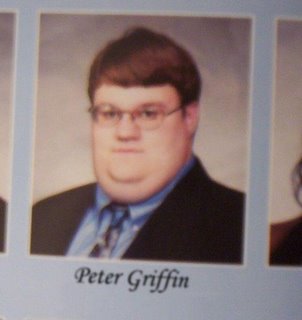
Don't want to overwhelm my readers (our department), so here are 7 links to help you call it a week:
Forget eHarmony and just settle for Brian
The State Season 1 is now available on DVD
Hot Swing Mashup of Swing Blade & Swingers
Mr. Rogers in a little different situation than Aki's post on his plea for public television
Watch out for something other than YouTube videos
Mike O’Connell + Dr. Ken = Red Vines (yes, that is so out that it's back in)
And finally, FedEx dumped via text
Until next time, keep it immature.
Trend: Visa Predicts (Holiday 2006)
 Visa predicts three key 2006 holiday sales trends.
Visa predicts three key 2006 holiday sales trends.
Visa USA has predicted that overall retail sales in the US, excluding vehicle purchases, for the 2006 holiday season will grow by 7.5% compared to 2005 - only slightly lower than the growth rate of holiday sales in the previous two years.
According to Wayne Best, senior vice president of business and economic analysis at Visa USA, this year's mixture of lower energy prices, positive employment trends, and a slow-down in the housing market suggests a sustainable holiday shopping season and bodes well for specific sectors such as personal entertainment, sporting goods and hobby stores, and specialty retailers. But this year's winners will also include e-retailers, who stand to benefit from overcrowded shopping malls.
Based on an analysis of spending using Visa-branded credit, debit and prepaid cards, Visa USA predicts three major trends for the coming holiday season:
1. Consumers will seek out value-for-money purchases
The Federal Reserve's pause in raising interest rates combined with the soft real estate market is expected to cause home owners to be cautious about using their home equity line of credit as a supply of disposable cash. Although Visa anticipates a decrease in big-ticket durable goods spending as a result, consumers are still expected to make "value purchases", including personal items and activities that are most valued (such as dining out, personal services and family entertainment), all of which will help drive personal entertainment consumption.
2. Travel and tourism off to a slow start
Fewer bookings in September 2006 (a month which is traditionally a strong indicator for holiday travel behaviour), combined with lower fuel prices, would suggest decreased travel and tourism spending during the holiday season, and an increase in consumers taking shorter, more regional trips.
3. The web remains a key tool for time-challenged consumers
As the US workforce continues to rebound, many consumers will find themselves short on time, thus turning to e-commerce channels for holiday shopping. So-called "Cyber Monday" (the Monday following the Thanksgiving weekend) will remain a popular time for online purchases, as consumers try to fit their shopping around busy schedules while avoiding crowded shopping malls.
"Americans will continue to look for value purchases that won't leave them strapped for cash in the long run, which is why big-ticket items such as furniture and appliances will not be as popular as in previous years," said Best. "The exception will be big-ticket personal entertainment products, such as high-definition televisions, which should see good growth."
Visa also expects big-box and general retail stores to experience moderate growth, but not quite at the same level seen in 2005. However, restaurants are expected to record positive holiday figures, at least in line with 2005's growth.
via Visa.com and Wise Marketer
What Type of Communitiy Would You Create?
Each day we have the opportunity to create a place in the world for our clients and for ourselves at Fallon. If you could start anew, where would your vision take us?
--------------------
The U sows utopian vision for its open land
Regents are considering a recommendation to make some Dakota County property a laboratory town for ideal 21st-century living.
Norman Draper, Star Tribune
Last update: November 09, 2006 – 11:32 PM
University of Minnesota officials Thursday unveiled an almost utopian vision for a community of 20,000 to 30,000 residents, to be built from scratch and serve as a laboratory for 21st-century living.
It would be a place where the latest advances in agriculture, nonpolluting energy and transportation would coexist with the arts, recreation and resources for lifelong education.
The site would be the university-owned UMore Park, a 7,800-acre tract in Dakota County most recently known for its part in a U stadium deal. It has been described as the largest contiguous piece of property owned by any land grant university in the United States.
The community plan was presented as a recommendation to the U's governing Board of Regents, which took no action Thursday. The regents were also offered two other options for the site: simply holding on to it, or selling it at wholesale prices.
"I find this to be exciting and inspiring, and it offers us an opportunity to think creatively not only about the property, but about the future of the university," said University President Robert Bruininks about the development idea.
The UMore site was deeded to the university by the U.S. War Department in the 1940s for $1. Almost 3,000 acres of it were traded last spring to the state of Minnesota in return for funding to help build a new Gophers football stadium on the Minneapolis campus. The remaining 5,000 acres would be the site of the new community.
Pending approval by the regents, U officials would like to have a master plan for the site completed by the end of 2007.
Change would take 30 years
The development would bring about such a metamorphosis in the site that it was characterized as "a Monarch caterpillar transformed into a butterfly" by U Vice President Charles Muscoplat.
Such a community would take 25 to 30 years to develop, Bruininks said. He characterized the plan as a way to further the education mission of the university and create an unparalleled opportunity: to construct a prototype living space designed for the benefit of humankind.
The plan would be financed initially by mining gravel on the site and the sale of recycled concrete left there, then by the sale of development rights to builders. According to Muscoplat and Bruininks, public funds would not be used to develop the site.
Muscoplat, who presented the recommendation to the regents, said the gravel deposits are worth between $14 million and $21 million, while sale of the recycled concrete could earn an additional $2 million to $3 million. Muscoplat did not disclose the value of the property.
Details about the proposed development have yet to be worked out. But university officials plainly envision a community that the knowledge and resources of the university could turn into a prototype for living in the 21st century.
The latest in agricultural advances could be used to produce disease-preventing food for the community. Solar cells, wind and renewable fuels would provide the energy. Buildings would be constructed of materials that represent the cutting edge of energy efficiency. A "health and wellness center" would serve the community, and particular attention would be paid to controlling such diet-related conditions as obesity, heart disease and diabetes. A "futuristic" library and technology-based learning center would be at the center of the community.
As part of their research, U officials visited similar planned communities in Denver and at the University of British Columbia, among other places.
Several regents posed hard questions about the concept: Would the U be competing with surrounding communities' development interests? Would the U's goal of using the community as a research site conflict with another goal -- making money from the property? If private developers are brought in, how much will their own plans conflict with the U's master plan? How would such a site be governed? And since the site was once used by the U.S. Army to produce gunpowder, is it contaminated?
"The challenge is we don't really know what the environmental impacts are," Muscoplat said. "The site might be contaminated, and it might not be contaminated. ... If it is, the answer is, we clean it up."
The concerns were tempered by enthusiasm for the concept.
"I think people will look at this in 30 to 40 years and say this is the most important decision that the university has made," Regent David Metzen said.
Bruininks said outside pressures to develop the site make it important for the U to work out a master plan to control the property's destiny.
"We are being surrounded by development," he said. "Development in the area is inexorable. We need to be part of it, or get out of it."
Norman Draper • 612-673-4547 • ndraper@startribune.com
Bankrupt!: War on Soldier Debt
 American soldiers are tangled in debt wars!
American soldiers are tangled in debt wars!
NPR reports on Pentagon's concerns about the potential security risks of service members carrying high levels of debt (a 9-FOLD INCREASE IN SOLDIERS STRIPPED OF SECURITY CLEARANCE DUE TO DEBT). The military is now trying to help those serving take control of their finances.
Capt Mark Patton of the Navy reports: "What we're finding is that the financial health of a service member is just as critical as his physical well-being, his morale, his family support."
Thursday, November 09, 2006
Are you a believer?
 A belief is something that we choose to see. Even though we can't prove it. Even though there maybe damn convincing alternatives. Belief is a funny old thing. And, clearly, we humans love dabbling in it.
A belief is something that we choose to see. Even though we can't prove it. Even though there maybe damn convincing alternatives. Belief is a funny old thing. And, clearly, we humans love dabbling in it.
Take belief in God. There's been a rash of books published in the last couple of years that expend thousands of pages of scientific argument to show us that God is a delusion - Richard Dawkins and Sam Harris being 2 key proponents - but maybe all belief is a delusion.
And maybe with the rise of the internet we are moving away from belief towards something else.
Are we in the business of getting people to believe in an idea?
Or are we increasingly going to have to scientifically prove an argument?
Reminder: British Advertising Awards @ Walker
Walker Art Center Presents the 2006 British Television Advertising Awards
The Popular Annual Screenings of Commercials from Across the Pond Return for Another Year
The 2006 British Television Advertising Awards program returns December 1–30 for another rousing run of screenings at the Walker Art Center, where last year more than 13,000 people saw the 2005 award-winning spots. Awards Administrator Peter Bigg will be on hand to introduce the opening-night screenings on Friday, December 1, at 7 and 9:30 pm. Remaining programs during the month include evening and matinee screenings.
Sure to sell out again this year, the annual British Television Advertising Awards has been delighting audiences in the Twin Cities for the past 20 years. Honoring the spry wit and ingenuity of the best British advertising, this new selection of original, daring, and hilarious commercials tours the U.S. with stops at New York’s Museum of Modern Art, the Los Angeles County Museum of Art, and the Museum of Fine Arts, Houston. The Walker’s audiences will enjoy the local twist—the voice of A Prairie Home Companion’s Garrison Keillor for the Honda ads that have taken the top prize for three years running.
Tickets for the British Television Advertising Awards screenings are $9 ($7 Walker members) and can be purchased by calling the Walker box office at 612.375.7600 or online at walkerart.org/tickets.
Special Discounts
Become a new Walker member and receive two free tickets for joining. Save $2 on each ticket purchased online ($3 service fee per order applies). For groups of 10 or more, tickets are $7 each. Call 612.375.7600 or visit walkerart.org/tickets.
Screening Schedule
2006, video, 70 minutes.
Click on link above for dates and times.
Tag, you're it

Speaking of being agile, I recently read an interesting article in the L.A. Times (via YPulse), which debates the importance of playing tag at school.
Some schools have started to discourage (and even ban) the game because it leads to fights, bruises, and scrapes. However, others argue that it allows children to socialize and helps them learn how to solve problems on their own. It is a one of the few games in which adults have no part/permission to play. Plus, it keeps the guys that make Scoobie Doo adhesive strips in business.
"Tag is a uniquely elemental game that develops naturally," says psychologist Fred Frankel, director of the UCLA Parent Training and Children's Friendship Programs. That's a good thing for kids at school and adults in the "real world." Tag can teach us agency peeps lessons about responsibility, responsiveness and collaboration as we adapt to better serve clients with smart solutions that evolve...and keep it fun! And kids can teach us that knowing the rules allows us to change them— think: freeze tag, laser tag, TV tag, etc.














